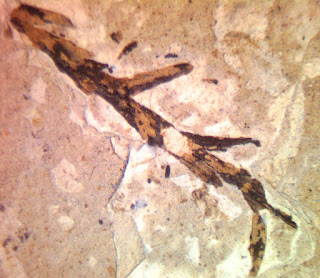Friday, July 31, 2020
Maple Seed Fossil
This image shows a Maple seed fossil found in the Florissant Formation of Teller County, Colorado, USA. The field of view (FOV) is 10 mm. It dates to the Eocene Epoch of the Paleogene Period.
Thanks to Kenny for the image.
Friday, July 24, 2020
Bicidiocrinus Crinoid Fossil
This crinoid appears to be a Bicidiocrinus crinoid calyx fossil. It was found in the Glen Dean Member of Grayson County, Kentucky, USA. The fossilized animal dates to Chesterian, Upper Mississippian Period. Thanks to Kenny for the images.
Labels:
calyx,
crinoid,
glen dean member,
Kentucky,
mississippian
Sunday, July 19, 2020
Florissant Formation Plant Fossil
This image shows an unknown plant fossil found in the Florissant Formation of Teller County, Colorado, USA. The field of view (FOV) is 15 mm. It dates to the Eocene Epoch of the Paleogene Period.
Thanks to Kenny for the image.
Labels:
colorado,
eocene,
florissant,
paleogene,
plant
Wednesday, July 15, 2020
Wasp Fossil
This image shows a wasp insect fossil found in the Florissant Formation of Teller County, Colorado, USA. The field of view (FOV) is 5 mm. It dates to the Eocene Epoch of the Paleogene Period.
Thanks to Kenny for the image.
Tuesday, July 14, 2020
Caddis Fly Insect Fossil
This image shows a Caddis fly insect fossil found in the Florissant Formation of Teller County, Colorado, USA. It dates to the Eocene Epoch of the Paleogene Period. Thanks to Kenny for the image.
Labels:
colorado,
eocene,
florissant,
insect,
paleogene
Monday, July 13, 2020
Maclurites Gastropod Fossil
This gastropod fossil was seen at the New Harmony Indiana USA Working Men's Institute Museum & Library in June 2020. It was identified as a Maclurites (Lesueur. 1818). The fossil dates to Middle Ordovician Period. Found in the Bobcaygeon Formation. It has a special significance because the fossil was named by naturalist Charles Alexandre Lesueur for geologist William Maclure. Both of these people lived at New Harmony in the 1820s.
Friday, July 3, 2020
Prehistoric Road Trip Videos
I watched a great show recently on Kentucky Educational Television (KET) Passport Internet streaming site about paleontology in the western United States. The show was called Prehistoric Road Trip hosted by Emily Graslie and available by WTTW Chicago. Three episodes make up this show. Below are embedded Public Broadcasting System (PBS) viewers for each one. They were recorded on 3 separate visits to five western states over a 9 week period in the summer of 2019.
Emily Graslie is the Chief Curiosity Correspondent of The Field Museum in Chicago and has been with them since 2013. She hosts the YouTube channel The Brain Scoop which as of this writing has had 31,258,841 total views. The museum is fortunate to have such an energetic and happy presenter for their videos.
What I liked most about the Prehistoric Road Trip episodes was the field collecting where they are splitting shale to find fish or plants. The hands on aspect of fossil collecting and then the interpretation of what one finds. Clues to what it might be, how it lived and died. When Emily visited the reservation with the dinosaur fossils just eroding out of the ground reminds me around Louisville at some sites where coral fossils just litter the area. Hopefully a good way can be found to preserve and display them.
Visit the website to learn more about the show and how to visit the fossil sites shown in it.
https://interactive.wttw.com/prehistoric-road-trip
Emily Graslie is the Chief Curiosity Correspondent of The Field Museum in Chicago and has been with them since 2013. She hosts the YouTube channel The Brain Scoop which as of this writing has had 31,258,841 total views. The museum is fortunate to have such an energetic and happy presenter for their videos.
What I liked most about the Prehistoric Road Trip episodes was the field collecting where they are splitting shale to find fish or plants. The hands on aspect of fossil collecting and then the interpretation of what one finds. Clues to what it might be, how it lived and died. When Emily visited the reservation with the dinosaur fossils just eroding out of the ground reminds me around Louisville at some sites where coral fossils just litter the area. Hopefully a good way can be found to preserve and display them.
Visit the website to learn more about the show and how to visit the fossil sites shown in it.
https://interactive.wttw.com/prehistoric-road-trip
Labels:
television,
The Field Museum,
youtube
Subscribe to:
Comments (Atom)







